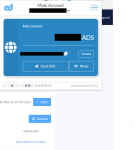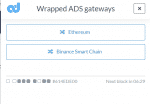Adshares is a brand new advertising network aimed at the crypto industry, and we’ve just signed up to it as an alternative to some of the other players in the market. In this article, we’ll have a look at the features for publishers running websites similar to ours, and see how it works.
So before we start, what does Adshares set out to do. It completed an ICO back in 2017, and since then has focused on building a decentralized blockchain based advertising network, obviously focused on crypto websites and crypto publishers. Given how hostile a lot of the traditional ad networks have been of late (looking at you Google Adsense), there is really only a handful of quality advertising networks out there that aren’t jam packed with low grade faucets. We’ve tried several networks such over the years, and many of them are to be honest a pain in the arse to use, and the major players have pretty high traffic bars for entry, as well as some quite high minimum withdrawals to get your earnings out.
The adshares platform is new, and right now at time of publication (October 2021) is offering some bonuses for new websites that sign up. These can be in a mix of bonus ADS (the erc-20 token that they do payouts in), which can be used against advertising your own site, or normal earnings which can be withdrawn to your favourite wallet or exchange.
In our case, as one of the early sites that signed up, we had to fill in an application form and then go through an onboarding process with the team, which was nice, done over Zoom and we were given a dedicated telegram chat with some of the team members to help us get things up and running. But right now, you can simply sign up at the adshares website and apply to be a publisher. Once approved, you’ll get a set of logins into their ad server and the first step is to add in your websites. We’ve only got the one, but publishers who run a portfolio of sites can add in each individual one they want to run ads on.
The next step is to set up your ad units, depending on what banner sizes you have for your website. For ours, we have a 728×90 and 300×250, and then a couple of different options that we could set up. When you set up your ad unit, you then have some further options. If you have a dedicated server, you can put some code on your configuration files which they say can allow you to circumvent adblock, however our web host doesn’t give us this option, so for this review we weren’t able to test this feature, which is a shame given around 35%/40% of visitors to our site has adblock enabled, or us using a browser such as brave.
There are also a couple of nice features that you can add to the adzone code which let you control things a bit more. There is an option that you can set a minimum CPM floor for the banners being shown, so if you only want to show ads above a certain price. There is also an option for showing ads to adblocked browsers only, as well as a final option for putting in a custom fallback option, so that if they don’t have an ad to show, you can revert to an alternative ad network instead which is a nice option. I did run into some issues which took a bit of tweaking when working with an adserver though in my own case, as the code had some commented areas, as did my fallback code, but after trying a couple of ways, I was able to get it working the way I wanted to.
For sites that want to (and I don’t), there’s an option to enable pop-up ads on desktop or mobile. There is also a category exclusion option section, so you can block ads from being shown in the first place from different categories of ads. So for instance, I don’t want porn ads showing on the site, so can exclude adult.
A really really nice touch was the option to go in and see which ads have been served in total. There’s a reject banners ads section on the website dashboard, and through this I can see all of the ads being shown on the site, and then choose to reject the ones I don’t like the look of. I haven’t seen this kind of control with other ad networks I’ve used, so it’s a definite unique selling point for the adshares network.
So once everything was configured, I set the ads to run on the site. Now BitcoinsInIreland.com isn’t exactly the biggest website on the internet, given we’re mainly focused on the Irish market, but within a couple of minutes impressions started showing on the dashboard, with ads serving fine. I left this run for about a fortnight before doing this writeup because I wanted to see how it performed over time. Our traffic is pretty closely tied to the ebb and flow of the crypto price but as time went on we could see steady impressions and clicks coming in from the ads.
Each hour, a payment (in ADS token) is applied to your account, so depending on how much traffic you have, you might want to wait a while for it to build up, or alternatively you can withdraw it to an ERC-20 compatible wallet or exchange that lists it directly. The exchange also features a referral program which lets you get up to 10% of revenue from advertisers you attract to the platform, or you can also choose when setting up a referral link to pass this referral bonus to the person you refer.
One really important thing for me to test is getting funds out of the ad server, and while there’s a couple of hoops to jump through, once set up the first time it was easy enough for subsequent referrals. Firstly, there is no minimum withdrawal amount, so you can withdraw at any point. The first thing to do was to set up an ADS Wallet (which is a browser extension), and once you’ve set this up with your private key and seed, you get a wallet address. Put this into your withdrawal page and then confirm the withdrawal by email. The payment was queued for payment, and the next block we received funds in our wallet.
Now there isn’t a whole lot of exchanges that are currently listing ADS, however there are defi platforms that support swapping it. The wallet makes this relatively easy. You have two options, firstly to wrap into eth (to swap on uniswap), although this option wasn’t really a runner given that there was a pretty high cost (especially at a low amount) to wrap it, and then get it onto uniswap, and then off uniswap. However, the way better option was to use Binance Chain. I had a small amount of BNB so created a binance wallet and send it to it. You choose to wrap your ADS, and there was a minimal fee of a couple of cent for doing this. This then quickly was received into my binance wallet. The I went to pancakeswap, and connected by binance wallet. I did the swap to Binance Wrapped Eth, which again had minimal fees (about 15c compared to about 1/3 of the amount if I used eth directly). This was swapped quickly, and then transferred to Binance where it could be traded into a main crypto or fiat and withdrawn. So is it the easiest way to do things? Not quite, but having the two options gives you choice, either you can deal with high gas fees on the ethereum blockchain, or use the much more efficient binance chain.
So overall, when looking at adshares from a publisher point of view, lets do a recap. Registering an account was pretty straightforward, and the dashboard gives you a reasonable amount of stats, which I’m sure will build up over time. There is a good documentation wiki that answers a lot of questions, and having access to the team on a chat for things that aren’t was handy. There’s definitely a bit of room for improvement which I’m sure will come over time (ie getting 2FA to secure the login and the reject categories wasn’t quite working but was fixed quickly once I reported it), but its certainly a nice alternative for crypto sites such as this one, and if you’re running a site that isn’t liked by Google adsense or some of the other networks that are out there, it’s a good option. I’ve had my trials of a lot of crypto ad networks over the year, and adshares seems to be putting a good amount of effort into trying to make something new, with options the other major crypto ad networks.



















